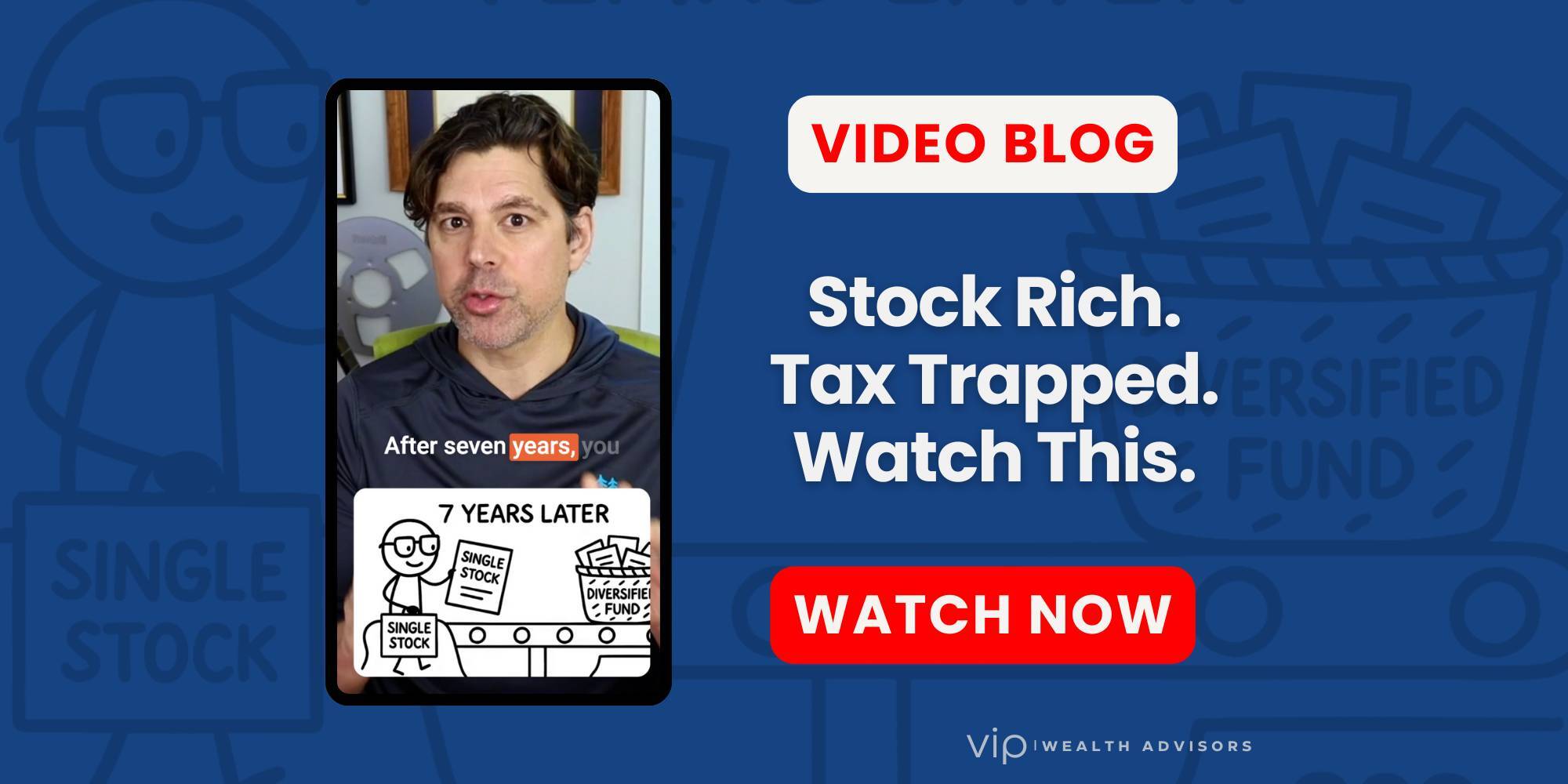You're sitting on a stock that changed your life. Maybe it was your startup equity, or a lucky bet on Nvidia or Tesla. The problem? You’re also sitting on a massive tax bill if you try to sell. A concentrated stock position may have helped you build your wealth - but now it’s a risk you can’t afford, and you feel trapped.
This is where advanced tax strategies come into play - specifically Exchange Funds and 351 Conversion ETFs. These aren’t everyday tools. They’re sophisticated legal strategies used by ultra-high-net-worth individuals and family offices to diversify without triggering capital gains tax.
In this article, we’ll break down both strategies in depth, explore real-world use cases, and help you understand when each strategy makes sense. If you’ve got $5M, $25M, or even $100M of low-basis stock, this is the kind of chessboard you should be playing on.
The Capital Gains Conundrum
Let’s say you hold $20 million in Nvidia stock with a $2 million basis. That’s an $18 million unrealized gain. Selling would likely cost you:
- Federal LTCG tax (20%) = $3.6 million
- NIIT (3.8%) = $684,000
- State tax (e.g., California ~13.3%) = $2.4 million
Total tax hit: over $6.6 million.
So you don’t sell. But you’re overexposed, under-diversified, and potentially one earnings call away from a disaster. You need a way out that doesn’t set fire to your gains.
Enter Exchange Funds and 351 ETFs.
Strategy 1: The Exchange Fund
What It Is
An Exchange Fund is a pooled investment vehicle—usually structured as a limited partnership—where multiple investors contribute their concentrated stock holdings. Over time, they receive a diversified basket of stocks, without triggering a sale.
These funds are governed under Section 721 of the Internal Revenue Code and are typically offered by firms such as Goldman Sachs, Eaton Vance, or Morgan Stanley.
How It Works
- You contribute $5M–$10M+ of a single low-basis stock (e.g., Apple).
- Others do the same with their stock.
- You receive LP units in a diversified fund.
- After 7 years, you can redeem your pro-rata share of the diversified basket.
Tax Consequences
- The initial contribution is non-taxable.
- The exchange after 7 years is also non-taxable, provided the structure follows IRS rules.
- You retain carryover basis in the stocks you receive - so tax is deferred, not erased.
Costs Involved
- Management Fees: Typically 0.75%–1.25% annually
- Performance Fees: Some funds may charge a back-end or performance-based fee
- Opportunity Cost: Limited customization and 7-year lockup
- Administrative Costs: Built into the fund’s NAV; not always transparent
Pros
- Simple to implement through institutional platforms
- No need to create a new legal entity
- Built-in diversification
Cons
- 7-year lockup
- No control over fund holdings
- Illiquidity
- Mismatched strategies possible
Strategy 2: The 351 ETF Conversion
What It Is
A 351 Conversion ETF is a bespoke, publicly traded ETF created by contributing appreciated assets under Section 351 of the IRC, which allows tax-free transfers of property into a corporation. White-label firms, such as Tidal, Exchange Traded Concepts, or Alpha Architect, commonly structure these ETFs.
This strategy enables you to create an ETF, seed it with your low-basis stock, and utilize in-kind transactions to rebalance into a diversified portfolio—all without incurring capital gains tax.
How It Works
- You or your advisor creates a new ETF (via a white-label platform).
- You contribute $25M+ of appreciated stock (e.g., Snowflake, Palantir).
- The ETF is launched with your holdings.
- Within days or weeks, the ETF rebalances via in-kind heartbeat trades into something like SPY or AGG.
- You now own diversified ETF shares—with no tax triggered.
Tax Consequences
- Initial contribution is non-taxable (Section 351).
- Rebalancing trades within the ETF are non-taxable (in-kind swaps).
- You now hold ETF shares with a carryover basis.
- Tax is deferred until the ETF is sold.
Sample Client Scenario
Let’s say Sarah holds $25M in Snowflake (basis $3M). She funds a custom ETF with the position. The ETF then swaps Snowflake for SPY and a few fixed income ETFs. Sarah now owns ETF shares worth $25M with a $3M basis—fully diversified, fully liquid, no tax paid.
What Can Be Held Inside a 351 ETF?
- Single stocks (e.g., Snowflake, Nvidia)
- Other ETFs (e.g., SPY, AGG, sector ETFs)
- Fixed income ETFs
- Individual bonds (e.g., Treasuries, corporates, munis)
Using ETFs inside the 351 fund helps satisfy the IRS’s 25/50 diversification rule:
- 25% Rule: No single position can be more than 25% of the portfolio
- 50% Rule: The top 5 positions cannot collectively exceed 50% of the portfolio
ETFs and bond funds naturally spread exposure across dozens or hundreds of securities, helping the ETF pass this test and qualify for non-recognition under Section 351.
Costs Involved
- ETF Formation/Legal Setup: $100K–$200K upfront
- White-label platform onboarding: $50K–$100K
- Annual Operating Expenses: $100K–$300K per year (compliance, audit, board, legal)
- Custom Fund Management: If outsourced, expect advisory fees
- Tax Compliance: Ongoing cost to track basis and file fund returns
Pros
- No lockup
- Full control and customization
- Transparent and liquid
- Diversification within days
- Flexibility in asset selection
Cons
- High setup and ongoing costs
- Requires careful tax and basis tracking
- Legal and operational complexity
What Happens After the Conversion?
Option 1: Keep the ETF Open and Publicly Tradable
- The ETF continues trading.
- You, as the original seeder, hold ETF shares that you can sell at any time (taxable event).
- Fund manager (or white-label platform) continues maintaining it.
- Other investors could theoretically buy into it, but often they don’t — it's not marketed.
This is the most common path for clients who want:
- Liquidity
- Ongoing tax deferral
- Custom index-like exposure
Option 2: Wind Down the ETF
Once the strategic tax move is done (i.e., your appreciated stock has been exchanged for diversified assets), you may decide to:
- Liquidate the fund
- Redeem ETF shares in-kind
- Shut down the ETF shell
This could make sense if:
- The ETF has served its purpose (e.g., post-diversification)
- You want to reduce the costs of maintaining the ETF
- You’ve sold or donated your ETF shares elsewhere
- You don't want to deal with compliance and board governance long-term
⚠️ Important:
Any liquidation or redemption must be carefully structured to avoid turning the transaction into a constructive sale or triggering gain. This is where a strong tax counsel and fund legal team are absolutely essential.
What Does ETF Closure Look Like?
If you decide to shut down the fund:
- File termination paperwork with the SEC.
- Distribute assets to remaining shareholders (usually just you or your family office).
- Dissolve the legal entity.
- File a final return and issue final shareholder tax reports (cost basis, NAV at closure, etc.).
It’s not unlike shuttering a mutual fund or private fund. The key is that:
- You don’t trigger a deemed sale
- Basis tracking is preserved
- Any remaining assets are distributed in-kind (not cash) if you want to avoid recognition
Planning Tip:
Many clients hold the ETF for years, integrating it into their broader portfolio:
- Can be transferred to trusts
- Used for tax-loss harvesting pairs
- Or held until death for step-up in basis
But if you want to unwind it, you can — you just have to do it intentionally, not casually.
Summary
-
Can I shut down the ETF later?
Yes, if done properly
-
Will it trigger tax?
Not if you redeem in-kind and follow the rules
-
Why keep it open?
Liquidity, long-term deferral, portfolio integration
-
Why close it?
Reduce costs, simplify structure, or exit strategy complete
Side-by-Side Comparison
| Feature | Exchange Fund | 351 ETF Conversion |
|---|---|---|
| Tax Deferral | Yes | Yes |
| Contribution Type | Stock only | Stock, ETFs, Bonds |
| Lockup | 7 years | None |
| Minimum | ~$5M per investor | $25M+ total seed |
| Liquidity | None until redemption | Fully liquid ETF shares |
| Control | None | Full control |
| Customization | Low | High |
| Transparency | Low | High |
| Use of ETFs/Bonds | No | Yes |
| Carryover Basis | Yes | Yes |
| Step-Up at Death | Yes | Yes |
| Setup Cost | Low–Moderate | High |
| Ongoing Costs | Moderate | High |
When to Use Each Strategy
Use an Exchange Fund if:
- You're contributing $5M–$10M and don’t want to deal with creating a new fund
- You're OK with a 7-year lockup
- You're looking for a passive, plug-and-play solution
Use a 351 ETF if:
- You have $25M+ in appreciated assets
- You want full control over the portfolio
- You need diversification quickly, not in 7 years
- You want liquidity and exit flexibility
- You’re a family office or highly sophisticated investor with tax counsel
- You're willing to absorb higher upfront and ongoing costs for greater flexibility
Estate and Tax Planning Implications
- Charitable giving
- Loss harvesting
- Lower-tax-bracket years
- CRUTs
- IDGTs
- Donor-Advised Funds
- Family partnerships
Sidebar: What Is a Heartbeat Trade?
A heartbeat trade is a strategy used by ETFs to remove appreciated securities without triggering capital gains.
Here’s how it works:
- A large investor (or authorized participant) contributes cash or securities to the ETF — an inflow.
- The ETF uses that inflow to swap out appreciated positions via an in-kind redemption with the same participant — the outflow.
- These paired inflows and outflows create a “heartbeat” pattern in the ETF’s daily fund flows.
🔁 Because the ETF doesn't sell anything — it simply exchanges securities — no taxable event occurs.
Why it matters:
Heartbeat trades are critical for 351 ETFs because they allow rapid, non-taxable rebalancing away from the original low-basis stock — and into diversified ETFs or bonds — without tripping capital gains.
Visual Flowchart: How a 351 ETF Works
(e.g., Snowflake, Palantir)
(e.g., SPY, AGG)
✔️ Same $25M value
✔️ Same $3M basis (carryover)
✔️ No tax triggered
Hypothetical Case Study: Before vs. After Portfolio
BEFORE: Concentrated Portfolio
Client: Sarah, a tech executive with a highly concentrated brokerage account.
| Holding | Value | Cost Basis | Unrealized Gain |
|---|---|---|---|
| Snowflake | $15,000,000 | $1,500,000 | $13,500,000 |
| Palantir | $10,000,000 | $1,000,000 | $9,000,000 |
Total Portfolio Value: $25,000,000
Estimated Tax Liability if Sold: ~$6M–$7M (depending on state)
AFTER: 351 ETF Conversion + Heartbeat Trade
Strategy: Sarah contributes appreciated shares into a custom ETF.
- $15M in SPY (broad market index)
- $5M in AGG (core bonds)
- $5M in sector ETFs (e.g., clean energy, healthcare)
Sarah now holds:
- $25M of ETF shares
- Same $2.5M cost basis (carryover)
- Zero tax triggered
Result: Fully diversified. Liquid. Tax deferred. Strategic optionality preserved.
Summary: Deferral is the New Alpha
Wealthy investors aren’t dodging taxes. They’re deferring them—strategically, legally, and with precision.
If you’re sitting on a massive low-basis position, the game isn’t just about beating the market. It’s about utilizing the tax code in your favor. Whether you choose an Exchange Fund or a 351 ETF conversion, you’re playing a different game entirely and doing it with purpose.
At VIP Wealth Advisors, we don’t do boilerplate plans. We do battle-tested, bespoke strategy. If you’re ready to reposition your wealth without triggering a tax minefield, it’s time to talk.
💼 Thinking About Diversifying Without Paying the IRS?
If you’re sitting on a massive low-basis stock position and want to explore advanced strategies like Exchange Funds or 351 ETFs, we can help.
At VIP Wealth Advisors, we help high-net-worth tech professionals and founders navigate the tax code with precision—no boilerplate plans, just smart strategy.
📅 Book Your Private Strategy Call
View More Articles by Topic
- Taxes (76)
- Financial Planning (40)
- Equity Compensation (34)
- Investments (23)
- RSU (21)
- Tax Policy & Legislation (18)
- Business Owner Planning (15)
- Incentive Stock Options (14)
- Retirement (14)
- Psychology of Money (10)
- Alternative Investments (9)
- Real Estate (9)
- AMT (8)
- Pre-IPO Planning (8)
- Estate Planning (7)
- Fiduciary Standard (6)
- NSOs (6)
- The Boring Investment Strategy (6)
- Capital Gains Tax (5)
- Crypto (5)
- QSBS (5)
- Post-IPO Tax Strategy (4)
- 401(k) Strategy (3)
- Private Investments (3)
- Q&A (3)
- Charitable Giving (2)
- ETF Taxes (2)
- IRA Strategy (2)
- International Financial Strategies (2)
- Irrevocable Trust (2)
- Legacy Wealth (2)
- Market Insights (2)
- Market Timing (2)
- Stock Market (2)
- Venture Capital (2)
- Video (2)
- AUM vs Flat Fee (1)
- Altruist (1)
- Atlanta (1)
- Book Review (1)
- Depreciation & Deductions (1)
- Education Planning (1)
- Precious Metals (1)
- QTIP Trust (1)
- Revocable Trust (1)
- Schwab (1)
- Solo 401k (1)








